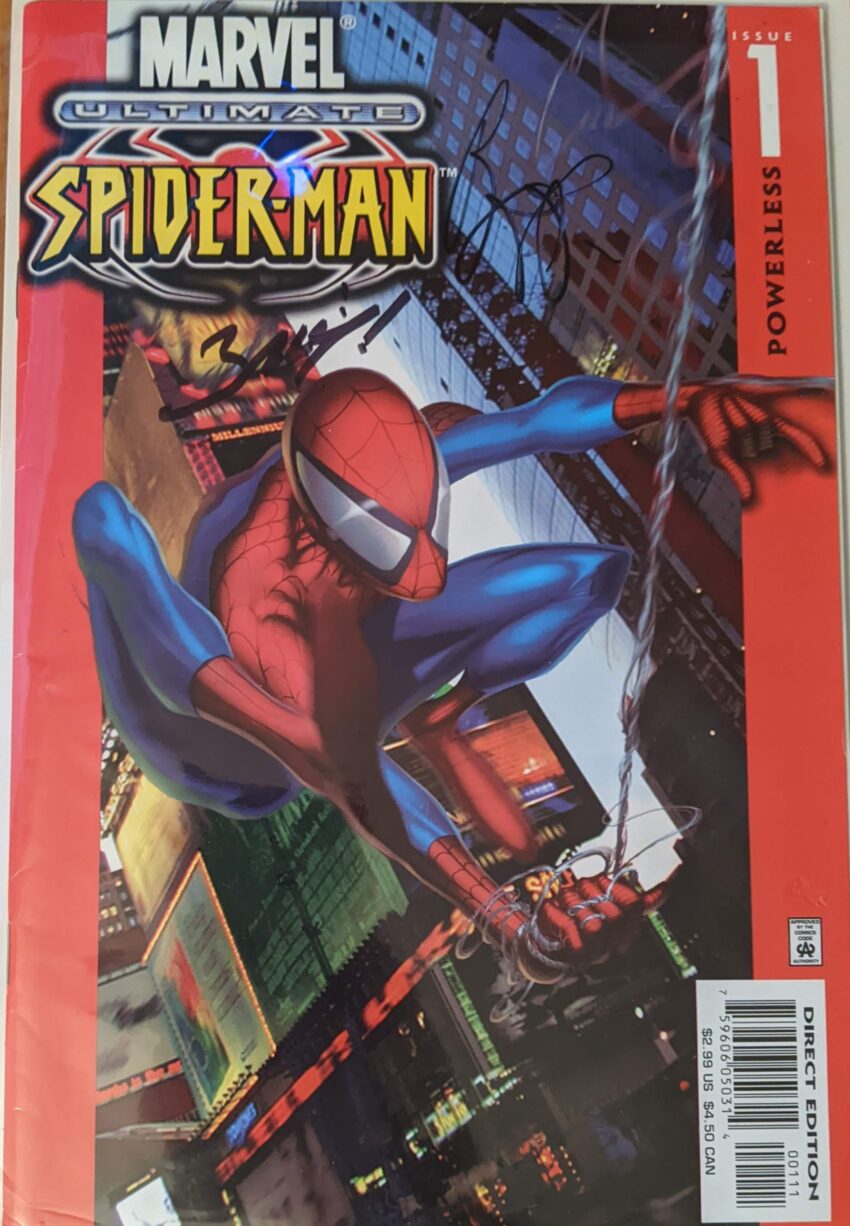It’s hard to overstate the importance of this comic. Which is a rare thing to say about something this recent, but it’s true. Ultimate Spider-Man launches a whole new line of comics, a surprising and (at the time) risky seeming move by Marvel’s new bosses, President Bill Jemas and Editor-in-Chief Joe Quesada. The Ultimate line will prove a hit, expand to more titles, and its take on the Avengers will have a huge impact on the MCU. So that’s an obvious and important legacy. But it’s also where writer Brian Michael Bendis became a star.
Bendis got his start writing & drawing black & white crime comics for indie publisher Caliber. His critically acclaimed crime noir books like AKA Goldfish and Jinx got the attention of one Todd McFarlane, who hired Bendis to write a book called Sam & Twitch, focusing on 2 detective characters from the Spawn comic. That book eventually paired Bendis with artist Alex Maleev. Then Bendis launched a comic about detectives investigating superpower-related crime with Michael Avon Oeming called Powers at Image and released the historical fiction crime noir Torso with Marc Andreyko.
Meanwhile, his good friend David Mack was writing Daredevil, and when his run concluded, the next arc was illustrated by him, but written by Bendis, who followed that with a years-long run illustrated by Alex Maleev. This led to Alias, the comic where he and Michael Gaydos created Jessica Jones, and then to him getting Avengers with David Finch and a procession of artists all in the process of becoming the definitive Marvel artists of the 2000s, where he turned the perennial also-rans into Marvel’s premier team book, must-read comics that defined what was happening in the Marvel line, and still does. He would go on to write dozens of titles, sometimes 4 at a time, across the Marvel publishing line for almost 2 decades. He really did become perhaps the single most important voice at the company since Stan Lee, racking up hit after hit. His importance to 21st Century Marvel is such that it would take too long to sum up his accomplishments. And all the while, he kept doing creator-owned material, even. But before any of that happened, based on Mack’s recommendation, Quesada invited Bendis to pitch stuff for Marvel, and the first thing he got on shelves was this.
By the release of USM 1 in 2000, the general feeling was Marvel Comics were impenetrable. That they had descended into such an endless web of continuity and self-referential stories that nobody could come in cold anymore and get much out of them. I actually think that’s largely unfair, especially after revisiting so much material from the period recently. Whether you’d LIKE some of this stuff is certainly a matter of personal taste, but you could pick up an issue ASM, Vol. 2 and get up to speed pretty easily. But that was the feeling among management. And thus was born the Ultimate line, a line of comics where your favorite heroes’ stories would start today instead of in the 60s. Unbound from continuity, starting fresh, this line would modernize the aging Marvel heroes and make them palatable to a new generation. If all that sounds like the mission statement of Chapter One, you’re not the only one who noticed. The overnight success of Ultimate Spider-Man was and probably still is a source of seething jealousy for John Byrne, and made Bendis, a lifelong fan, into an enemy without the 2 ever even speaking. Which is insanely petty and stupid, but as we’ll see, this book is as good at what Chapter One was trying to do as Chapter One was bad at it. But nobody knew that when this issue came out, obviously. Whether this gamble would pay off was anybody’s guess. I can recall my local newspaper surprisingly having a short comics column sometimes (Not that I read the paper, but my Mom would show it to me), and reading there, of all places, that Marvel was rebooting with this Ultimate thing. The article made it sound like the real Marvel U was being tossed out, DC style, replaced with this, and I couldn’t believe they would do such a crazy thing. And, you know, they didn’t. Quality journalism!
At any rate, working from a setup created by Marvel President Bill Jemas, Bendis set out to tell the story of a 15-year old Peter Parker becoming Spider-Man in 2000 instead of 1962. His partner for this endeavor? Mark Bagley. Bags, it seems to me, has spent much of his career trying to get away from Spider-Man, and failing. Like John Romita, Jr. (who, in 2022, did a convention panel literally called “Anything But Spider-Man” to talk about all the other things he’s done for a change), he did so much Spider-Man that he is forever tied to the character in a lot of peoples’ minds. Getting off ASM to go do other things, leaving Marvel to work for DC, nothing he’s ever done has kept him away from Spider-Man for long. He seems to have accepted being the Spider-Man guy in recent years. And why not? You can do worse than being instantly associated with perhaps comics’ most popular character. But when he got this gig, he has said, it was just a job to him. He was tired of Spider-Man and not in the mood, and he, like many people, wasn’t sure what to make of this thing. He was asked to draw the first storyline so they’d have a familiar hand at the wheel, and he planned to bounce after. He did good work, but his heart wasn’t initially in it. Until he started reading the scripts and getting excited about the book, and thus was born the longest of Brian Michael Bendis’ many long creative partnerships. When he and an artist hit it off, you can expect to see them working together basically for the rest of their careers, on and off. But wait til you see how long they work together on this book!
USM has gone on to be a classic series, and is now more famous for spawning Miles Morales (Created by Bendis and artist Sara Pichelli). It’s one of the best superhero comics ever made, in my opinion. And I haven’t seen it in many years, so I’m genuinely very excited to revisit this material.
I’m reading the first 3 issues out of an oversized reprint that included all 3. One of the ways Marvel was trying to get right after emerging from bankruptcy was a “no overprint” policy. This meant if comic shops ordered 5 total copies of a book, only 5 would be printed. Which is an exaggeratedly small number, but the point is, for the first time in decades, a hit Marvel comic was a real collector’s item, because if you didn’t get it, you couldn’t get it. USM 1 is now worth a considerable sum, and given that shops traditionally assume 2nd issues will sell less and order less as a result, #2 is really scarce, too. I missed #2 when it came out (because my shop didn’t hold me a copy despite me putting it on my pull list), only acquiring a copy from a friend in the 2010s. So I bought this reprint of 1-3 hastily produced to help people like me when the first issues sold out so quickly, and it seems smarter to just use it than open 1 & 2.
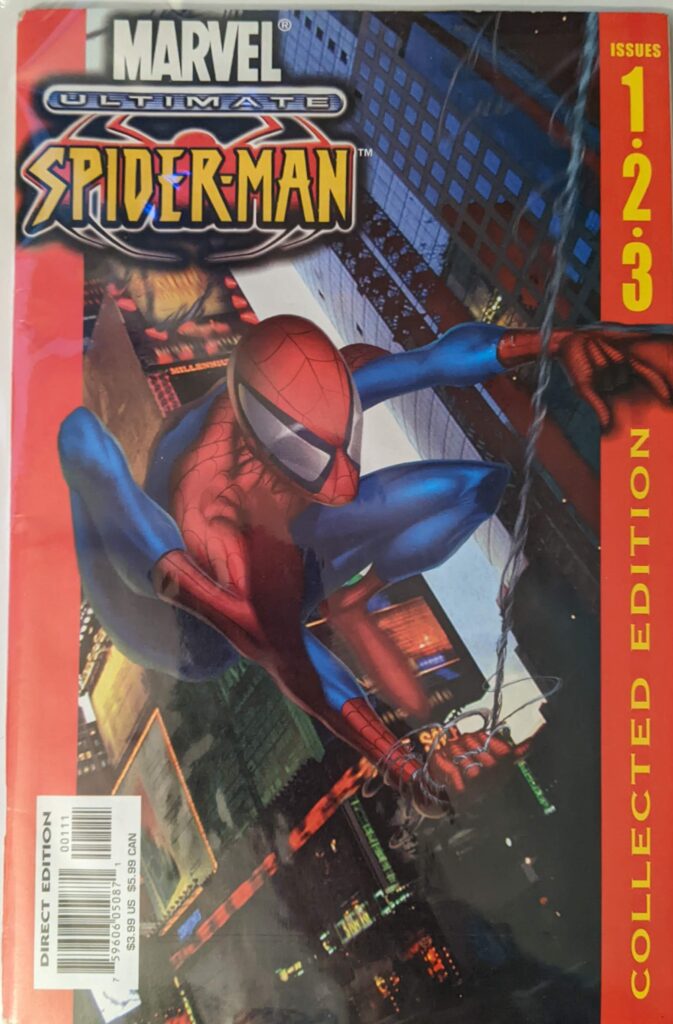
The cover to USM 1 is by Joe Quesada and Richard Isanove, slapping a Joe Q Spidey on a photograph background and digitally painting it to fit in better. This bold look, along with the unique trade dress of the bars on the sides, made the Ultimate line stand out. Ultimate X-Men (If anything could use a break from self-referential continuity, it was and still is X-Men), which launched not long after, had a Quesada Wolverine cover with a similar setup. I do not like this cover. This spindly little Spider-Man with an enormous head looks goofy to me. But it worked, and the photoreal color and background kind of set the tone for the more “realistic” approach to superheroes that you’d find within, despite the decidedly unrealistic Spider-Man drawing. So then! After maybe my longest preamble ever, Ultimate Spider-Man #1, but Bendis & Jemas, Bagley, Art Thibert and Steve Bucellatto.
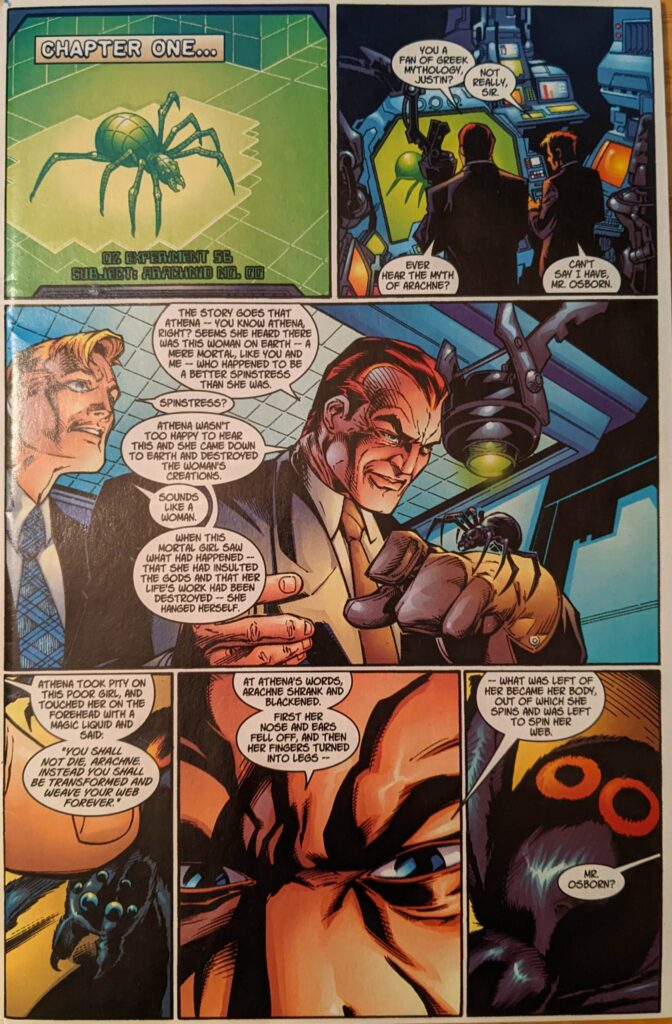
Maybe not what you’d expect to get started, but “not what you’d expect” is this series’ MO. As Norman Osborn is distracted by a phone call from his lawyer, ranting across a 2-page spread about his new wonder drug, OZ, he hands the test spider to that other guy, who freaks out, dumps it in a glass canister, and runs off. But he didn’t shut the lid or anything, so the spider gets loose. I wonder where THAT could lead…

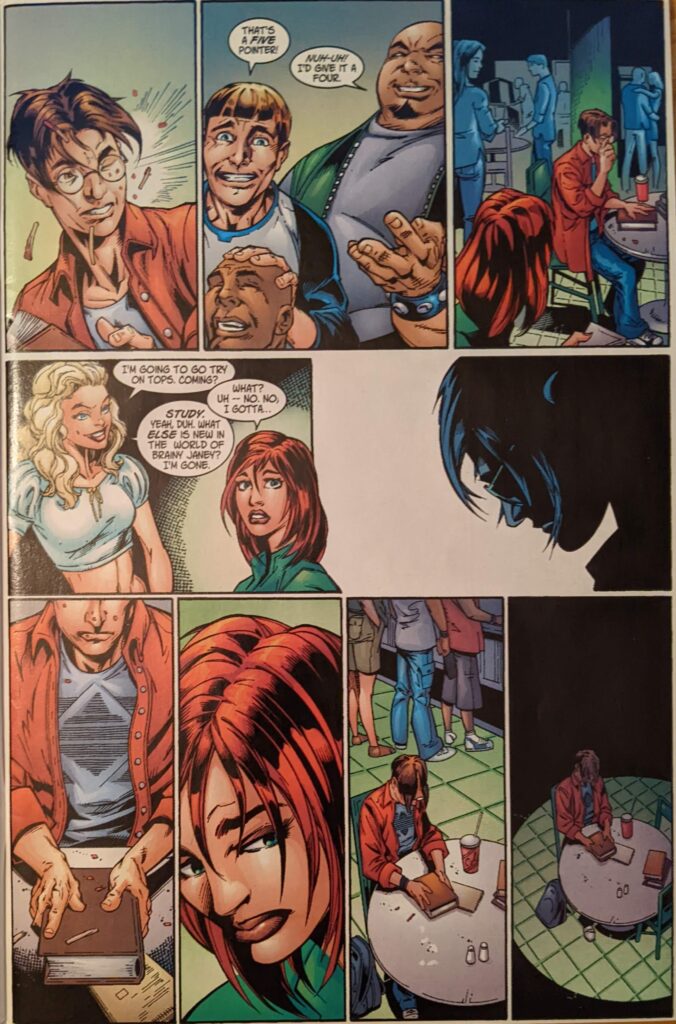
And here we have our kids. Peter Parker, getting it even worse than he did in the Marvel U. Flash Thompson and Kong (Named on the next page). And “Brainy Janey.” So right off the bat, we have one of the series’ biggest changes. MJ is now Peter’s high school classmate. Most adaptations seemed to skip Gwen and go right to MJ. The 90s cartoon, the Raimi movie soon to follow this series, etc. And we’re also getting the famous Bendis dialogue and pacing. Bendis said he would go hang out in the mall and listen to teenagers talk. And all this gets 4 pages, really letting things breathe. His whole approach is markedly different. Next page, a whole taco goes flying at Peter. And then…
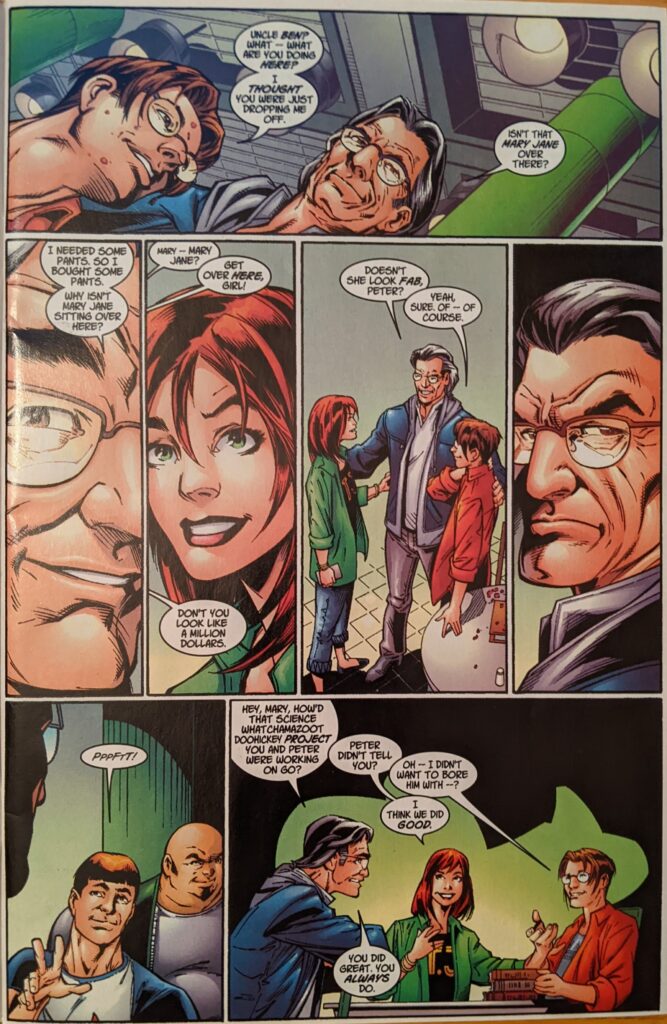
Uncle Ben, aging hippie. Makes perfect sense in 2000. The next day at school, Peter is being harassed by Flash & Kong when they’re defused by Harry Osborn, fellow jock and sympathetic ear to Peter. He doesn’t stand up to them or try to shame them, he just manages to talk them out of being jerks, riding the line. A school administrator appears and tells Peter if these boys are giving him trouble, to come see him, making things worse.
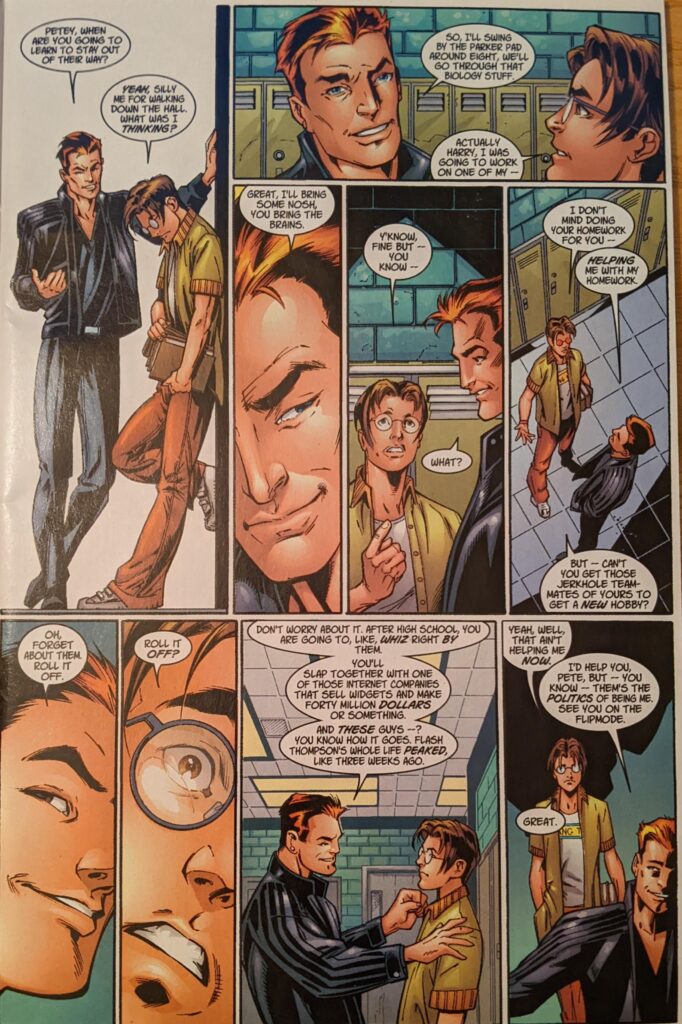
In gym class, Peter is made to display his lack of basketball skills. The PE teacher is worse about it than Flash. Rather crucially, some kids are shown being on Peter’s side, which… The 60s material, literally every kid in school hating or ignoring Peter just seemed like too much to me. None of these nicer kids are going to become main characters or anything, but it’s just nice that they exist. Now it’s time to meet another familiar face…
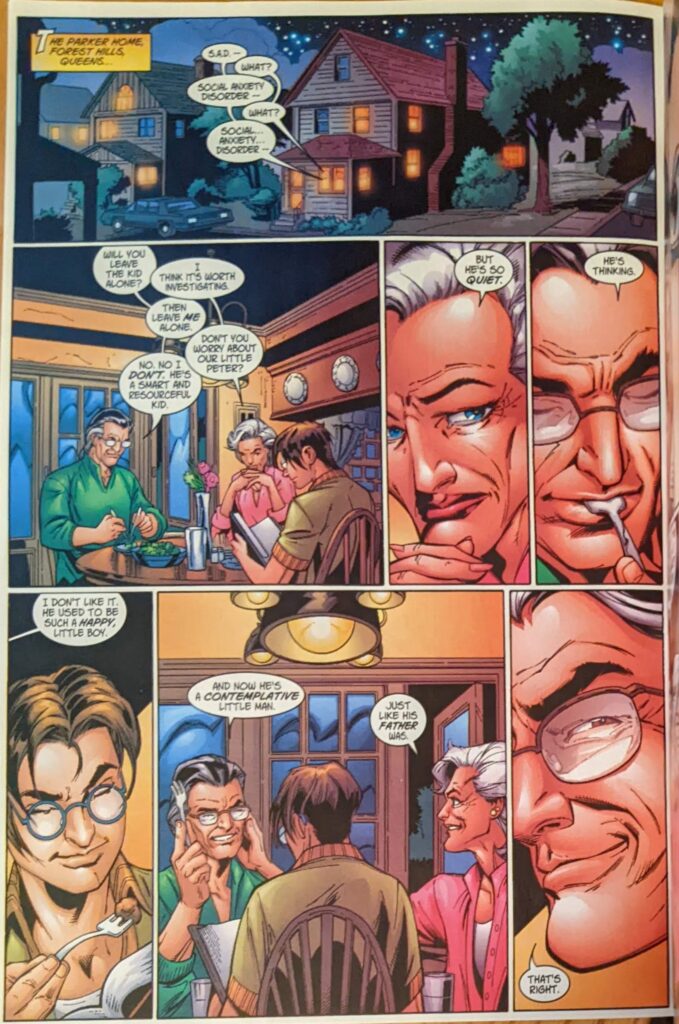
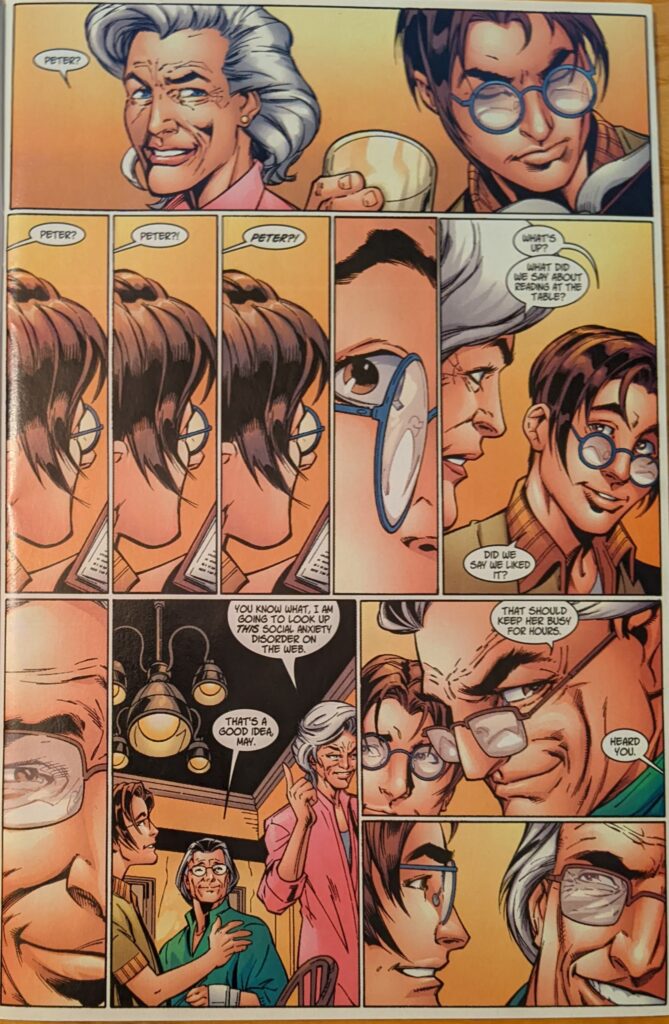
Some pitch perfect home life stuff. And not too dissimilar to what Jenkins was doing in PPSM 20, it must be said. Trying to make things more natural, more real, and to show what a happy family they were. Later, in the basement, Harry is over, looking at all the weird science stuff around. Peter inherited it all from his dad, he says. Harry asks what happened to his folks, and he says they died in a plane crash. Peter reveals his dad was working on a formula for a molecular adhesive before he died, and Peter has been trying to complete it. And, I mean… perfect. 15-year old Peter Parker casually whipping up this impossible scientific marvel in a single panel in 1962 was a lot to sign on for. The organic webshooters Raimi would later give him in the 2002 movie robbed his Spider-Man of all the stuff you can do with mechanical ones, like proving how smart Peter is, running out of web in a fight, etc. But this? Perfect solution. Spider-Man will have a web, Peter will be a genius, but it’s within reason. Later that night, we see Norman once more ranting into a phone, as Harry comes in and reminds his dad that his high school class is visiting the labs tomorrow. For this, Norman yells for Harry’s mother to come get “this kid” out of here. Her name is Martha, by the way. So we see Harry doesn’t have a very good home life, as you’d expect. And now…
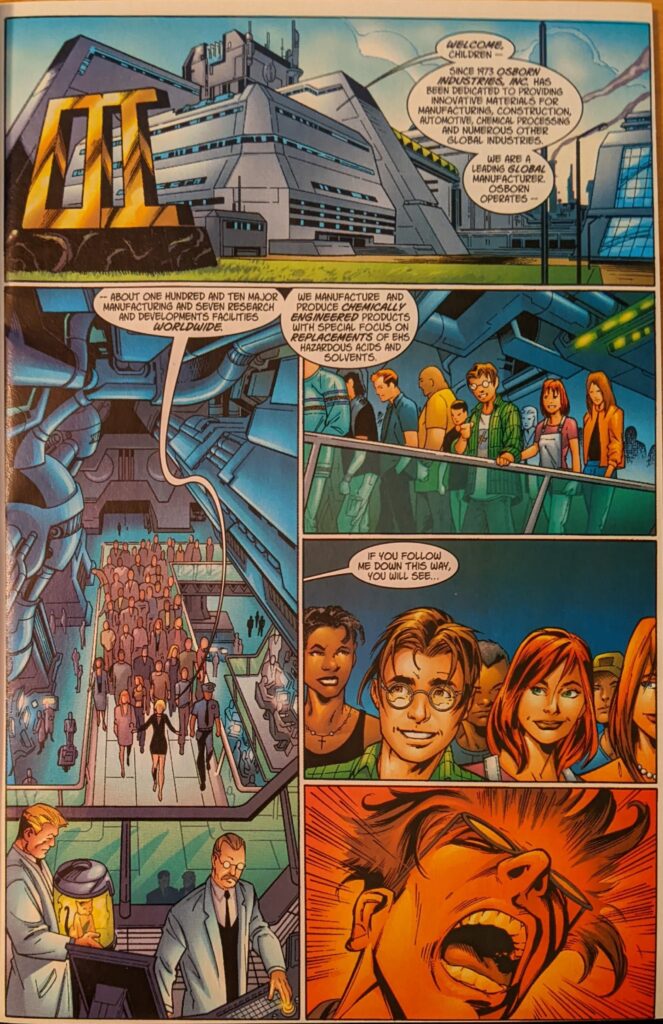
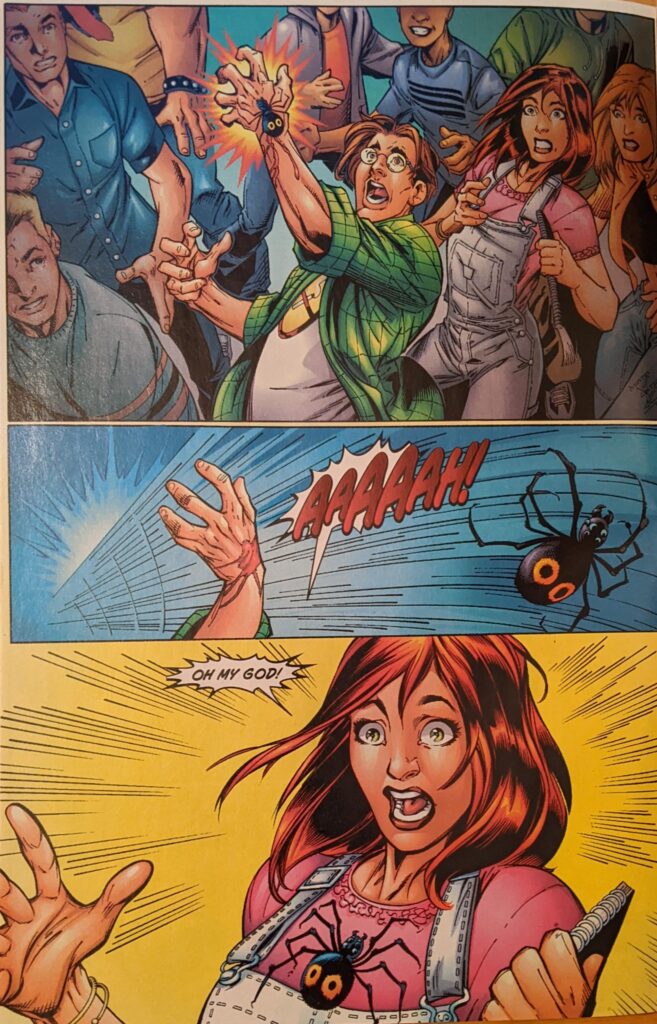
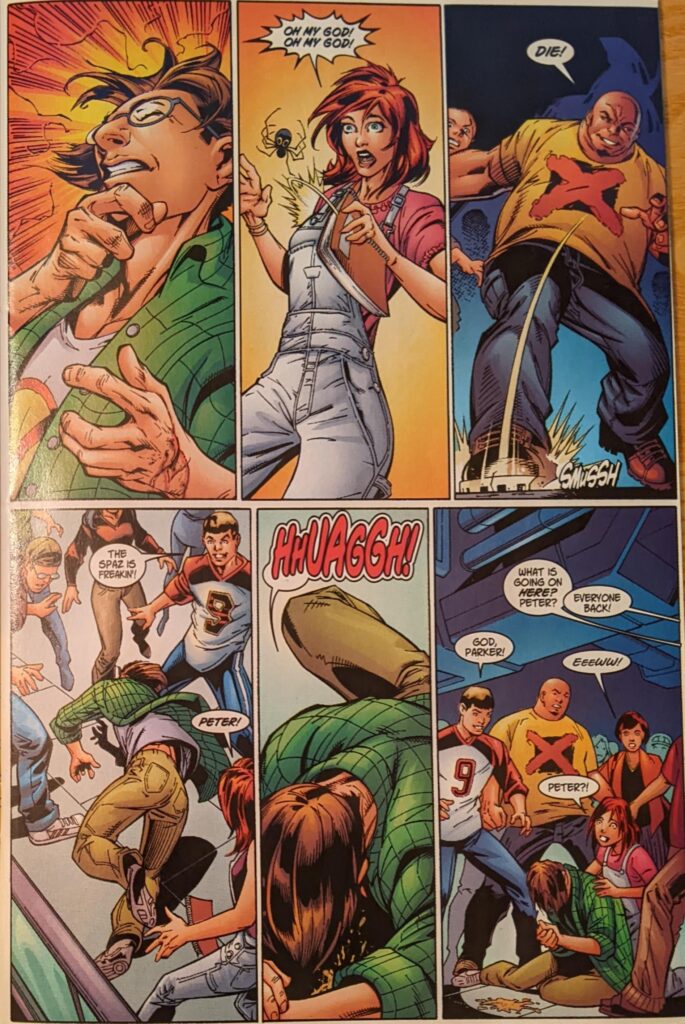
A fair bit more dramatic than in 1962, but no one got blown up this time, so better than 1999. Peter passes out, and we skip ahead to the kids going back to school, and Peter being told Aunt May will be waiting for him there. Peter’s feeling better, but embarrassed by what happened. MJ tries to console him, and it’s nice. What’s not so nice…
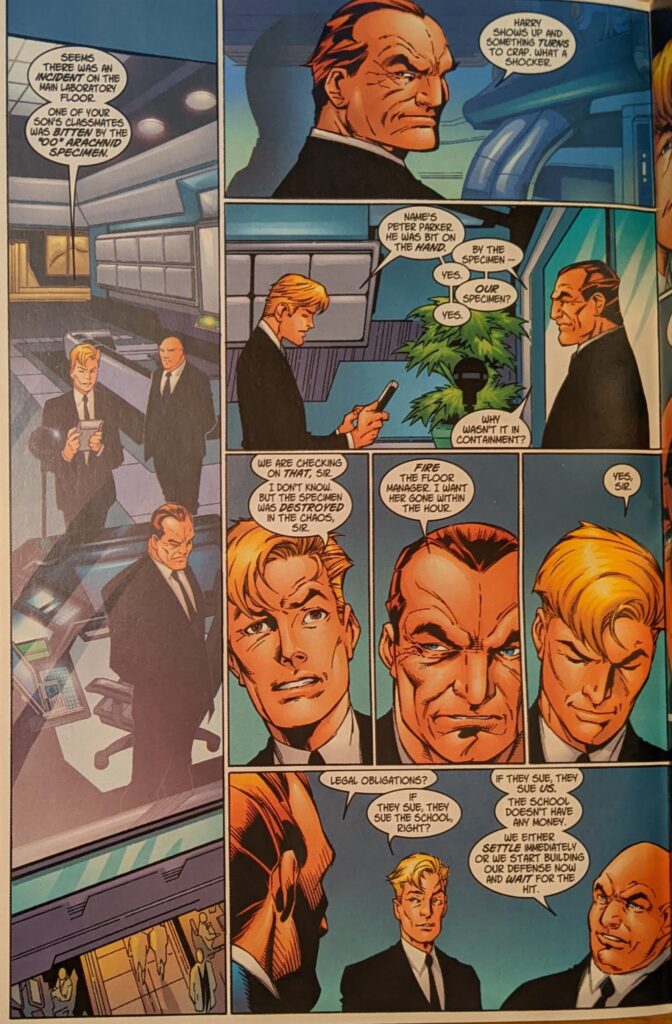
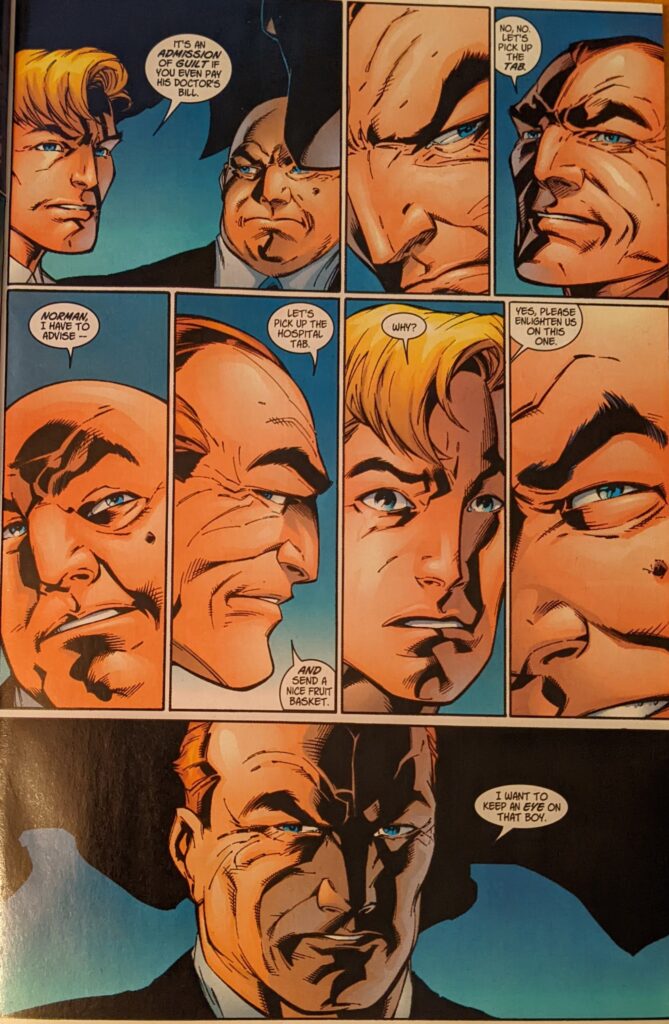
Uh-oh! As Peter sleeps it off, May & Ben discuss it. May mentions OI paying the hospital and sending the fruit basket, and Ben guesses it’s because they expect a lawsuit. But, of course, they won’t sue, he says, no harm done. And he doesn’t want to damage Peter’s friendship with Harry. He says it’s back to normal. And the next day at school, it seems like it is…
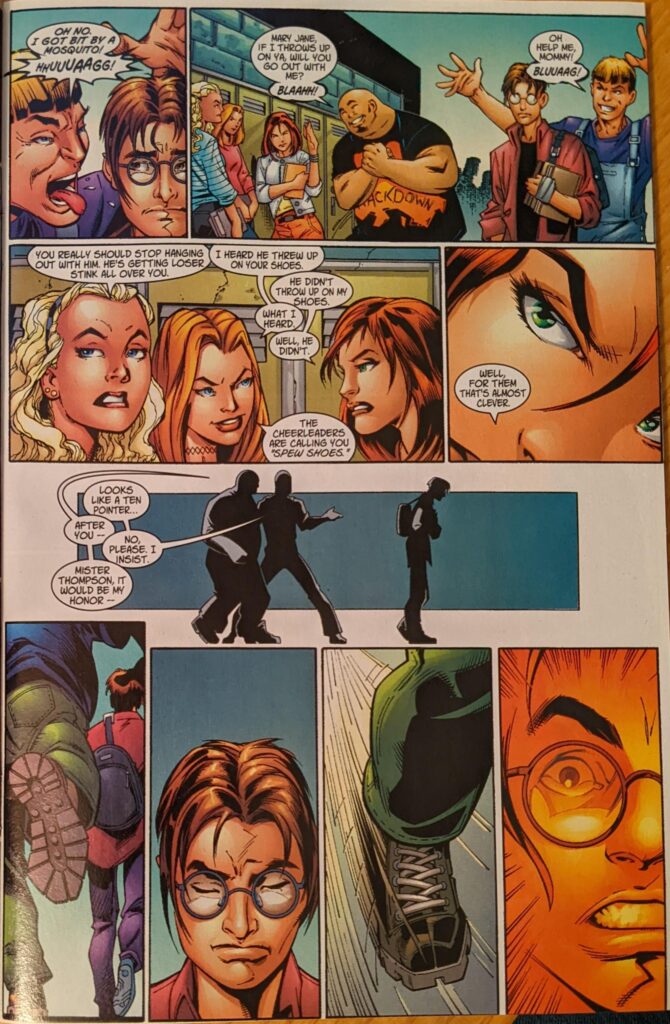

Everyone is shocked by this development, including Peter, who passes out. He wakes up in the hospital with May at his side. A doctor asks him various questions, but Peter says he feels fine, and swears he’s not on any drugs. A nurse takes his blood for testing, but then a mysterious back-gloved hand steals the sample and replaces it. Back at OI, Norman studies the blood and determines his OZ drug is killing Peter. With the threat of lawsuits and financial ruin on the horizon, Norman’s lackey who caused all this in the first place suggests they kill Peter before he can die from their drug.

Another great bit from the Parker household. As Peter goes out walking, Norman gives his goon the greenlight to hit Peter with a car. But once again, Peter senses it coming. He does a big Spider-Man flip over the speeding car, then runs to check on the driver, assuming something is wrong. But as the goon produces a gun, Peter gets another buzz that tells him to run away, and he does. And when Norman hears about all this, he angrily calls off the hit, saying he wants to study this kid, not kill him.
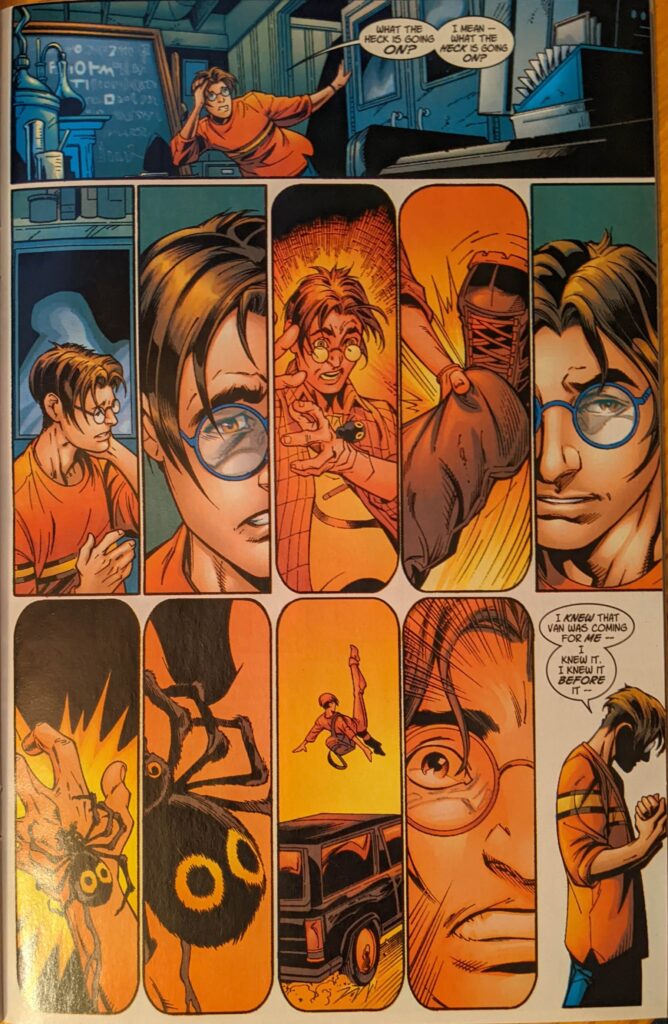
Cut to a 2-page spread of Peter researching spiders, testing his own blood, and being shocked by the results. But he’s been doing all this instead of going to school, and that lands him in trouble with May & Ben. They get into an argument, and Peter accidentally pulls some plaster off the wall with his fingertips in his frustration before being sent to his room.

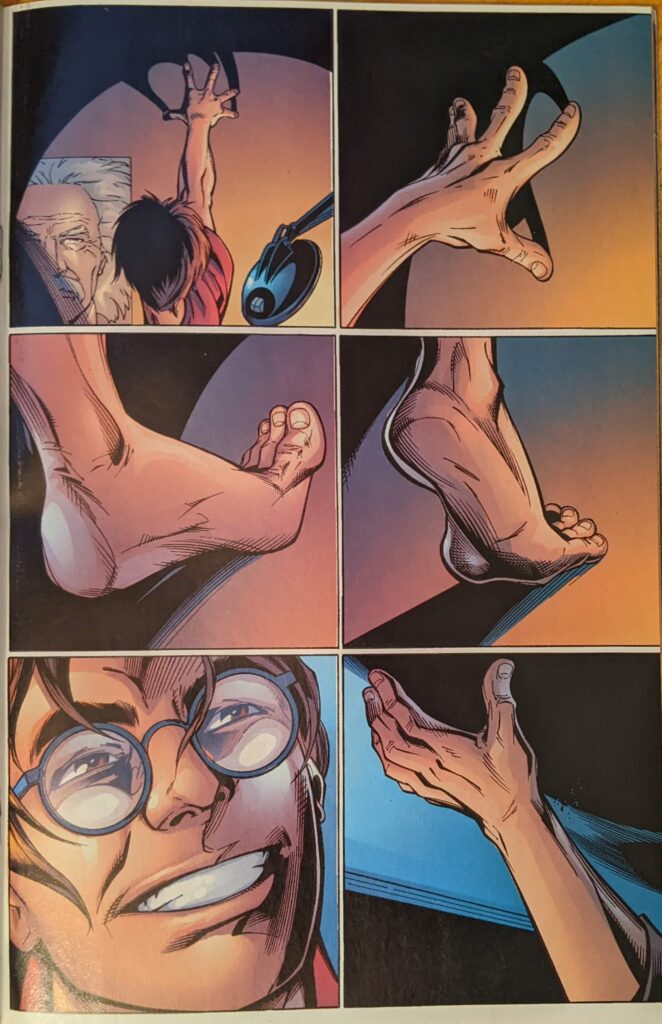

And that’s the end of USM #1. There is no Spider-Man in it. There’s no Spider-Man at all! But there’s a fantastic foundation for one, one given more time to develop than literally any superhero origin before, and really since, too. This pacing was a radical choice for an already risky book. But it worked! It so worked. The natural dialogue, the real world vibe, and the slow pace made it stand out. Instant success, a groundswell of hype. I was totally onboard. I believe this is the book that drove me to Bendis’ forum for the first time to say how much I enjoyed it. I would be a regular on his forums for more than a decade, meeting people I’m still friends with. Marvel’s most important 21st century writer to date. The foundations of the MCU. Miles Morales. And for me personally, decades of memories with that writer’s other fans. Who could’ve guessed so much would come from some weird new Spider-Man comic that didn’t even have Spider-Man in it? This issue came out the same month the mainline titles were on #22. Part one of the Senator Ward finale in ASM and Sandman in PPSM. This… was something different.

